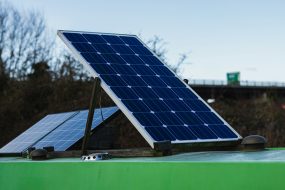
Many South African households now have the opportunity to invest in solar and backup power solutions that not only provide protection against load-shedding and power outages but also help reduce electricity costs.
In the past, the high cost of solar equipment meant that homeowners had to wait several years to recover their initial investment before they could start benefiting from savings on their electricity bills. For most people, the primary reason for installing these systems was energy security rather than cost reduction.
However, recent drops in the prices of solar panels, inverters, and batteries—combined with rising Eskom electricity tariffs—have significantly shortened the payback period for solar investments.
While many solar power companies have only recently begun promoting cost savings as a key selling point, one company, Stage Zero, incorporated this philosophy into its business model from the start.
Stage Zero’s founder and CEO, Abraham van der Merwe, told MyBroadband that the company was designed from the ground up to focus on financial savings, not just power security. To create a sustainable business model, Stage Zero identified ways to minimize operating costs and maximize efficiency, ensuring their systems could be cost-effective for as many customers as possible.
A Smarter Way to Calculate Savings
Stage Zero has introduced an advanced online calculator that allows potential customers to estimate how much they could save with a solar and backup power system. While other companies offer similar tools, Stage Zero’s calculator is specifically designed to cater to each user’s unique setup.
To use the calculator, users need to enter their address, property and connection type, whether they use prepaid or postpaid metering, and their average monthly electricity expenditure. The system integrates utility mapping to automatically retrieve applicable electricity tariffs based on the user’s location.
Additionally, Stage Zero utilizes data from multiple weather stations and existing customer installations nationwide to accurately estimate solar power generation in specific regions. This results in highly precise savings projections, rather than relying on generalized averages or theoretical system performance.
Real-World Cost Comparisons
Testing the calculator revealed that many households using Eskom’s standard tariff structure would pay less overall if they switched to an entry-level solar and backup system.
For example, Stage Zero’s “Essentials” system—priced at R1,199 per month on a rental basis—includes six 550W solar panels, a 3kW inverter, and a 5kWh battery. According to the company, this system can provide up to five hours of backup power for lights, essential appliances, and all kitchen devices.
Using Stage Zero’s calculator, it became evident that the savings on electricity bills often offset the rental cost.
According to Eskom’s 2025/2026 retail tariff plan, the average residential user under the Homepower 4 tariff consumes approximately 656kWh of electricity per month, amounting to an electricity bill of R2,144.
When applying this data to a household in an Eskom Direct-supplied area in Johannesburg, the calculator estimated a monthly electricity bill reduction of R1,203. After adding the R1,199 rental fee, the total monthly expense dropped to R2,140—R4 less than relying solely on Eskom.
Although the immediate savings might seem minimal, this figure includes the added benefit of backup power during outages.
Cost Comparisons Across Major Cities
The same 656kWh average consumption was applied to electricity tariffs across South Africa’s major cities to determine how much households could save using a Stage Zero system. In nearly all cases, switching to solar resulted in cost reductions compared to using the grid alone.
The only exception was Durban, where users would pay about R162 more per month for load-shedding protection. This is due to KwaZulu-Natal’s relatively lower solar energy potential compared to other provinces, though it still remains above the global average.
However, given Eskom’s history of increasing electricity prices at a rate higher than inflation, the additional cost in Durban could shrink or even turn into a saving in the coming years as solar rental prices remain more stable.
Impressive Accuracy and Future-Proofing
Stage Zero’s calculator has proven to be highly accurate, particularly with its utility mapping capabilities. The following table summarizes the potential savings for households consuming Eskom’s typical residential average:
| Power Utility | Average Bill Without Solar & Backup | Electricity Savings with Solar & Backup | Solar Rental Price | New Total Cost with Solar & Backup | Difference |
|---|---|---|---|---|---|
| Bloemfontein (Mangaung) | R1,990 | -R1,295 | +R1,199 | R1,894 | -R96 |
| Cape Town | R2,609 | -R1,362 | +R1,199 | R2,446 | -R163 |
| Durban (Ethekwini) | R2,195 | -R1,037 | +R1,199 | R2,362 | +R162 |
| Eskom Direct | R2,144 | -R1,203 | +R1,199 | R2,140 | -R4 |
| Gqeberha (Nelson Mandela Bay) | R2,392 | -R1,293 | +R1,199 | R2,298 | -R94 |
| Johannesburg | R2,203 | -R1,258 | +R1,199 | R2,144 | -R59 |
| Nelspruit (Mbombela) | R2,288 | -R1,248 | +R1,199 | R2,239 | -R49 |
| Pretoria (Tshwane) | R2,417 | -R1,479 | +R1,199 | R2,137 | -R280 |
The data used in this table is based on prepaid customer tariffs with single-phase connections.
The Bottom Line
With Eskom’s ongoing electricity price hikes and the increasing affordability of solar power, investing in a solar and backup system is becoming an attractive and financially viable option for many South African households.
Stage Zero’s advanced calculator provides an easy way for consumers to see exactly how much they could save by switching to solar. While the immediate savings might not seem drastic in some areas, the long-term benefits of energy independence, load-shedding protection, and stable electricity costs make it a compelling investment.
For those looking to take control of their electricity costs and avoid the frustration of power outages, solar power solutions like Stage Zero’s are paving the way for a more reliable and cost-effective energy future in South Africa.
Photo by micheile henderson on Unsplash












